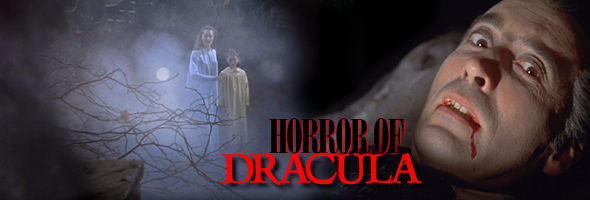
Color, 1958, 82 mins. / Directed by Terence Fisher / Starring Peter Cushing, Christopher Lee, Michael Gough, Melissa Stribling, Carol Marsh / Music by James Bernard / Warner (US R1 NTSC) / WS (1.78:1) (16:9)
A zippier and more full-blooded film (in every sense) than Hammer's previous outings, Horror of Dracula (or simply Dracula as it's known everywhere except in the U.S.) benefits greatly from Cushing's confident performance and a number of classic set pieces, namely Harker's ordeal at the castle, the investigation into Lucy's nocturnal activities
For such a crucial horror title, Horror of Dracula has not fared very well on home video. Much of its original luster has been dulled by muted and cropped video transfers, as well as a notorious laserdisc pressing which omitted part of a gruesome staking at the 55-minute mark. (For the record, all three stake hits and the blood-spewing are here on the DVD, though upon close analysis the reinstated footage appears to be lifted from a different and slightly more degraded print.) Though the film still betrays its age at times, Warner's anamorphic transfer looks comparatively polished and boasts some wonderfully striking colors; reds are appropriately saturated and balance nicely with director Terence Fisher's skillful incorporation of blue and gold into the set design. Flesh tones are also noticeably improved, and the graininess which has become part of the film's video fabric has been thankfully decreased. Resolution looks impressive on a standard monitor but when blown up to home theater size, detail can be quite soft in numerous shots, particularly the studio-bound Color, 1957, 83 mins. / Directed by Terence Fisher / Starring Peter Cushing, Hazel Court, Christopher Lee / Music by James Bernard / Warner (US R1 NTSC) / WS (1.78:1) (16:9)
Curse of Frankenstein is really Cushing's show all the way, and his forceful characterization would determine all of the future Hammer titles in this series as well. While each subsequent film offers a somewhat different slant on this scientist determined to tread into a forbidden domain, this first offering is a far cry from the well-meaning but doomed protagonist of Shelly's novel. Though bereft of any dialgue, Lee cuts an imposing figure as the monster and offers the film's unquestionable showstopper involving a strategically aimed bullet. This moment remains shocking
Though it plays as loose and easy with the Bram Stoker novel as any of its competitors, Hammer's first attempt to bring Dracula to the screen remains in many respects the consummate adaptation. Shot in voluptuous Technicolor and paced like a speeding train, this film is the one most responsible for kick-starting the Hammer horror avalanche which continued for the next two decades, and while subsequent films in the series managed to outdo this one in terms of both style and bloodshed (Brides of Dracula hits the perfect balance), this one continues to stand the test of time with admirable grace.
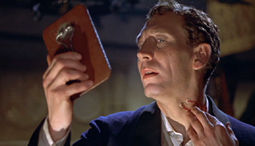 Jonathan Harker (John Van Eyssen) travels to the remote castle of Count Dracula (Christopher Lee) under the guise of some harmless library cataloguing, but in reality he intends to put an end to the bloodsucker's reign of terror. Unfortunately the genteel Englishman is lured in by a mysterious female guest and falls prey to the vampire's feeding habits, forcing intrepid Professor Van Helsing (Peter Cushing) to investigate. Back in London, Dracula vampirizes the women at the Holmwood estate including Jonathan's fiancee, Lucy (Carol Marsh), and Mina (Melissa Stribling), the wife of Lucy's brother, Arthur Holmwood (Michael Gough, best known as Alfred from the Batman movies). Will Arthur and Van Helsing come to the rescue? Can the fanged fiend be stopped?
Jonathan Harker (John Van Eyssen) travels to the remote castle of Count Dracula (Christopher Lee) under the guise of some harmless library cataloguing, but in reality he intends to put an end to the bloodsucker's reign of terror. Unfortunately the genteel Englishman is lured in by a mysterious female guest and falls prey to the vampire's feeding habits, forcing intrepid Professor Van Helsing (Peter Cushing) to investigate. Back in London, Dracula vampirizes the women at the Holmwood estate including Jonathan's fiancee, Lucy (Carol Marsh), and Mina (Melissa Stribling), the wife of Lucy's brother, Arthur Holmwood (Michael Gough, best known as Alfred from the Batman movies). Will Arthur and Van Helsing come to the rescue? Can the fanged fiend be stopped?
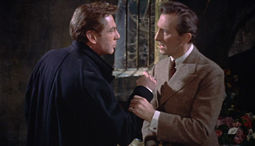 (which culminates in the best jolt in the Hammer catalog), and of course the oft-imitated, action-packed finale which plays like a vampiric twist on an Errol Flynn movie. There isn't much room for subtext here, of course, and the film's frequently noted eroticism has been greatly muted over the years, but its status as a top caliber popcorn muncher remains unchallenged. Lee also deserves props for making such a vibrant impression with a comparatively tiny amount of screen time; unfortunately his participation would scarcely grow in future outings, causing him to vocally deride his appearances in these films.
(which culminates in the best jolt in the Hammer catalog), and of course the oft-imitated, action-packed finale which plays like a vampiric twist on an Errol Flynn movie. There isn't much room for subtext here, of course, and the film's frequently noted eroticism has been greatly muted over the years, but its status as a top caliber popcorn muncher remains unchallenged. Lee also deserves props for making such a vibrant impression with a comparatively tiny amount of screen time; unfortunately his participation would scarcely grow in future outings, causing him to vocally deride his appearances in these films.
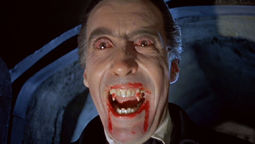 exteriors. As with the theatrical prints, facial details sometimes appear blurred and overall the film will still look dated to those expected a crisp, megabudget Warner restoration on the order of North by Northwest. The film elements look clean and free from wear. As with their release of The Mummy, the decision to letterbox the film at 1.78:1 will no doubt ruffle a few feathers; the framing lops off as much on the top and bottom as it adds to the sides, but the compositions look more spacious and evenly composed than the claustrophobic full frame version. However, viewers with 16:9 capability may find the headroom awfully tight if their set overscans to 1.85:1, which shears off too much headroom for comfort. The mono audio is limited by the dated materials but sounds robust enough, with James Bernard's thunderous score coming through passably if lacking the stomach-rumbling bass that characterizes his theme on the CD soundtrack. Considering the past track record of Hammer titles on DVD it wouldn't be outrageous to expect a special edition treatment for a title this important, but alas the only extras are the familiar theatrical trailer (in much better shape than on previous compilations) and a few cursory text supplements hopping through the Hammer-Dracula history. Given Lee's fluctuating opinion on discussing his Dracula appearances, his absence here isn't too surprising, but a few goodies to put the film in context (or even a simple gallery) would have been a welcome gesture.
exteriors. As with the theatrical prints, facial details sometimes appear blurred and overall the film will still look dated to those expected a crisp, megabudget Warner restoration on the order of North by Northwest. The film elements look clean and free from wear. As with their release of The Mummy, the decision to letterbox the film at 1.78:1 will no doubt ruffle a few feathers; the framing lops off as much on the top and bottom as it adds to the sides, but the compositions look more spacious and evenly composed than the claustrophobic full frame version. However, viewers with 16:9 capability may find the headroom awfully tight if their set overscans to 1.85:1, which shears off too much headroom for comfort. The mono audio is limited by the dated materials but sounds robust enough, with James Bernard's thunderous score coming through passably if lacking the stomach-rumbling bass that characterizes his theme on the CD soundtrack. Considering the past track record of Hammer titles on DVD it wouldn't be outrageous to expect a special edition treatment for a title this important, but alas the only extras are the familiar theatrical trailer (in much better shape than on previous compilations) and a few cursory text supplements hopping through the Hammer-Dracula history. Given Lee's fluctuating opinion on discussing his Dracula appearances, his absence here isn't too surprising, but a few goodies to put the film in context (or even a simple gallery) would have been a welcome gesture.

The first horror outing for Hammer Studios seemed like a gamble at the time. Universal had already exhausted the classic literary monsters by sinking them into parodies, and science fiction had taken hold of youthful imaginations at matinees around the world. So they revived Mary Shelley's literary chestnut about playing God, pumped it up with gory Technicolor, brought aboard the relatively unknown Terence Fisher to direct, and cast two non-marquee character actors, Peter Cushing and Christopher Lee as Baron Victor Frankenstein and his monstrous creation, respectively. The rest, as they say, is history.
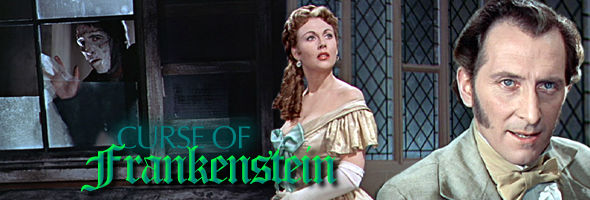 Telling his life story to a priest while in prison, privileged Baron Victor Frankenstein explains how he was determined from youth to push the limits of society and scientific discovery. Frankenstein recruits his friend and former tutor, Paul (Robert Urquhart), for a little dabbling with the dead, to the ignorance of his lovely cousin, Elizabeth (horror icon Hazel Court), or the sultry housekeeper with whom he's having an affair. First the men reanimate a small puppy and decide to take a crack at a human body, stealing the body of a criminal from the gallows. The resulting creature proves to be an unstable and violent entity though nowhere near as dangerous as its Machiavellian creator, who even resorts to murder to accomplish his questionable ends.
Telling his life story to a priest while in prison, privileged Baron Victor Frankenstein explains how he was determined from youth to push the limits of society and scientific discovery. Frankenstein recruits his friend and former tutor, Paul (Robert Urquhart), for a little dabbling with the dead, to the ignorance of his lovely cousin, Elizabeth (horror icon Hazel Court), or the sultry housekeeper with whom he's having an affair. First the men reanimate a small puppy and decide to take a crack at a human body, stealing the body of a criminal from the gallows. The resulting creature proves to be an unstable and violent entity though nowhere near as dangerous as its Machiavellian creator, who even resorts to murder to accomplish his questionable ends.
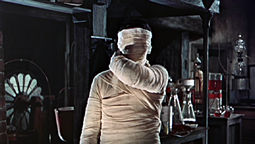 today and no doubt had audiences reeling in the days before Blood Feast. Cushing's surgical procedures are also far grislier than the sanitized antics of Colin Clive in the Universal days, and of course with Court on hand the sex appeal is amped up as well. That said, the film now seems much more quaint than its standard companion piece, Horror of Dracula, and the pacing occasionally lags a bit longer than it should. Great fun all the same, but it's really a primer for Cushing's more outrageous sequels before Fisher finally gave the doc his swan song in the delirious Frankenstein and the Monster from Hell. It's also worth noting the participation of screenwriter Jimmy Sangster, who became a frequent Hammer scribe and was responsible for some of their most memorable titles, such as the often overlooked masterpiece, Scream of Fear (and where's that DVD, Columbia?).
today and no doubt had audiences reeling in the days before Blood Feast. Cushing's surgical procedures are also far grislier than the sanitized antics of Colin Clive in the Universal days, and of course with Court on hand the sex appeal is amped up as well. That said, the film now seems much more quaint than its standard companion piece, Horror of Dracula, and the pacing occasionally lags a bit longer than it should. Great fun all the same, but it's really a primer for Cushing's more outrageous sequels before Fisher finally gave the doc his swan song in the delirious Frankenstein and the Monster from Hell. It's also worth noting the participation of screenwriter Jimmy Sangster, who became a frequent Hammer scribe and was responsible for some of their most memorable titles, such as the often overlooked masterpiece, Scream of Fear (and where's that DVD, Columbia?).
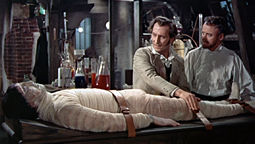 Skillfully mounted and sporting attractive period detail, Curse of Frankenstein is a visually enjoyable film but looks restrained compared to Fisher's more confident Technicolor splashings of Horror of Dracula and The Hound of the Baskervilles (or the even more striking chromatic fiestas of The Mummy). For some reason all of the Frankenstein films tend to have a more subdued palette; here everything is predominated by shades of blue, green, and gray. The occasional splash of red turns up here and there, of course, but it's a visually odd film which substandard video transfers have managed to render almost monochromatic (e.g., the pasty-looking widescreen laserdisc a few years ago). The elements look clean enough, while the anamorphically enhanced, widescreen framing keeps the crucial details in check but may irritate viewers used to the more generous vertical framing of previous video editions. Headroom is more spacious than on Horror of Dracula, however, and even blown up to a 1.85:1 ratio it registers well. Unfortunately the only extra is the theatrical trailer, which looks like it has seen better days.
Skillfully mounted and sporting attractive period detail, Curse of Frankenstein is a visually enjoyable film but looks restrained compared to Fisher's more confident Technicolor splashings of Horror of Dracula and The Hound of the Baskervilles (or the even more striking chromatic fiestas of The Mummy). For some reason all of the Frankenstein films tend to have a more subdued palette; here everything is predominated by shades of blue, green, and gray. The occasional splash of red turns up here and there, of course, but it's a visually odd film which substandard video transfers have managed to render almost monochromatic (e.g., the pasty-looking widescreen laserdisc a few years ago). The elements look clean enough, while the anamorphically enhanced, widescreen framing keeps the crucial details in check but may irritate viewers used to the more generous vertical framing of previous video editions. Headroom is more spacious than on Horror of Dracula, however, and even blown up to a 1.85:1 ratio it registers well. Unfortunately the only extra is the theatrical trailer, which looks like it has seen better days.
